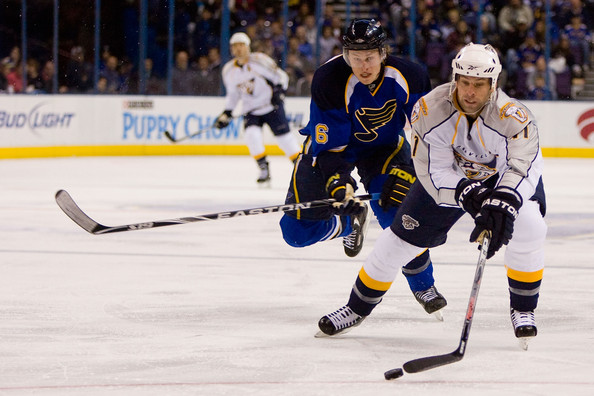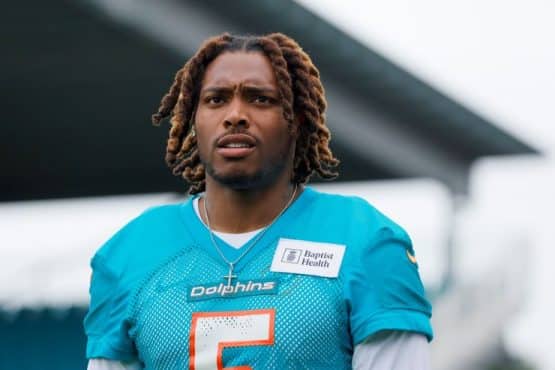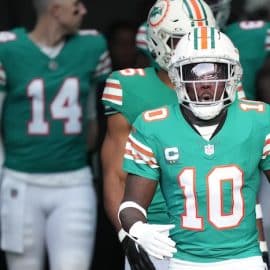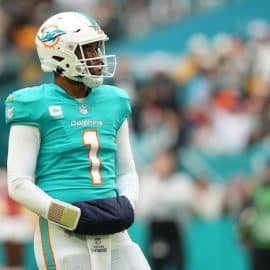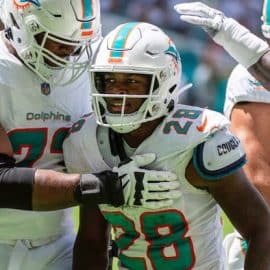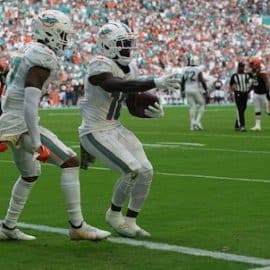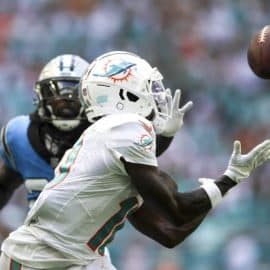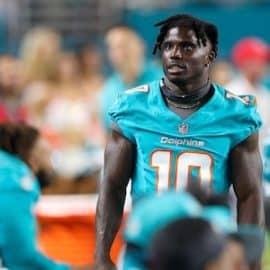Five years ago today, on January 2nd of 2008, Jeff Ireland was officially hired as general manager of the Miami Dolphins. What followed has been half decade of team failure that most fans would like to forget as soon as possible – five straight non-winning years and four finishes as the 3rd best team in the AFC East division. Some things changed during this time. Coaches came and went as well as starting QB’s. The stadium was renamed and the uniforms were even altered with a shiny new logo and team slogan for good measure (ironically enough, “It’s Our Time”). The results, however, remained disappointing with one clear constant: Jeff Ireland, GM of the team.
Much has been said about Ireland’s skills in regards to talent acquisition. Critiques of his performance in both the draft and free agency abound. Free agency aside, I’d like to focus on Ireland’s performance in the draft. It should be noted that the draft plays a vital component in maintaining one of the league’s prized characteristics – parity. By ensuring that a team’s performance is inversely linked to its draft order, the league has a built in mechanism to allow for the non-winners to acquire key pieces to turn things around.
Moreover, as opposed to other professional leagues – such as MLB – (excellent wiki page on this topic), the NFL’s salary cap rules make talent/value acquisition via the draft of paramount importance; there simply isn’t enough money to build a successful team predominantly through free agency. A recent piece from the WSJ actually pointed out just how powerful having less money spent on a young QB can be in building a playoff contender. It can be read here.
In order to quantify the team’s draft performance during Ireland’s tenure, I took a look at the Dolphins’ five drafts from 2008 through 2012. This year’s 2013 draft was left due to the short time horizon since these players were acquired. Specifically, I wanted to see the number of draft picks chosen in rounds one through three still on the team and playing in either a starting or reserve role. The first three rounds were chosen, as opposed to the later rounds, because it is well known that the likelihood of a player finding a home on a roster is correlated with draft position (one recent interesting article on this topic).
In order to compare the team’s draft performance to a successful benchmark, I also gathered information on the 12 teams that made this year’s playoffs. On a technical note, injured players still on a given team were considered to be a starter or reserve based on their pre-injury role. Now, let’s look at the numbers.
|
|
Total Drafted |
% on team |
% starting |
% reserves |
|
Dolphins |
17 |
47.06% |
62.50% |
37.50% |
|
Seattle |
13 |
61.54% |
100.00% |
0.00% |
|
Carolina |
13 |
46.15% |
66.67% |
33.33% |
|
Philadelphia |
15 |
66.67% |
70.00% |
30.00% |
|
Green Bay |
15 |
80.00% |
66.67% |
33.33% |
|
San Francisco |
14 |
57.14% |
75.00% |
25.00% |
|
New Orleans |
11 |
63.64% |
57.14% |
42.86% |
|
Denver |
19 |
73.68% |
71.43% |
28.57% |
|
New England |
24 |
54.17% |
76.92% |
23.08% |
|
Cincinnati |
20 |
65.00% |
76.92% |
23.08% |
|
Indianapolis |
15 |
53.33% |
75.00% |
25.00% |
|
Kansas City |
20 |
65.00% |
76.92% |
23.08% |
|
San Diego |
14 |
78.57% |
72.73% |
27.27% |
|
NFC Playoff Avg |
13.5 |
62.52% |
72.58% |
27.42% |
|
AFC Playoff Avg |
18.7 |
64.96% |
74.99% |
25.01% |
|
Playoff Team Avg |
16.1 |
63.74% |
73.78% |
26.22% |
What’s interesting to see here is not only how the Dolphins compare to these winning organizations, but also the differences between the playoff teams. Over the last 5 years, the Dolphins have had one more pick than the average playoff team. However, they are substantially below the average percentage of players still on the team – 47.06% vs 63.74%. Furthermore, of the players still on the team, the Dolphins have less starting (62.5% vs 73.78%) and more in reserve roles (37.5% vs 26.22%). Intriguingly, not all the playoff teams have built draft success the same way. While Seattle has only had 13 total picks, with 61.54% still on the team, all 8 of these players are starters; on the other hand, New England only has 54.17% of their drafted players still on the team, but they’ve had an astounding 24 picks – they’ve made up for low yield with high volume.
As teams naturally churn a roster, it becomes increasingly less likely that a player will remain on the roster as time goes on. To correct for the reality that players drafted 5 years ago are less likely to contribute to a team’s current performance than more recent draftees, I also broke down the data to include just the drafts between 2010 and 2012.
|
|
Last 3 yrs drafted |
LST 3 Yrs, % on team |
LST 3 Yrs, % starting |
LST 3 Yrs, % reserves |
|
Dolphins |
9 |
88.89% |
62.50% |
37.50% |
|
Seattle |
8 |
87.50% |
100.00% |
0.00% |
|
Carolina |
8 |
62.50% |
80.00% |
20.00% |
|
Philadelphia |
10 |
70.00% |
57.14% |
42.86% |
|
Green Bay |
9 |
88.89% |
50.00% |
50.00% |
|
San Francisco |
9 |
77.78% |
71.43% |
28.57% |
|
New Orleans |
8 |
75.00% |
50.00% |
50.00% |
|
Denver |
12 |
91.67% |
72.73% |
27.27% |
|
New England |
14 |
78.57% |
72.73% |
27.27% |
|
Cincinnati |
12 |
83.33% |
70.00% |
30.00% |
|
Indianapolis |
10 |
60.00% |
83.33% |
16.67% |
|
Kansas City |
12 |
75.00% |
66.67% |
33.33% |
|
San Diego |
10 |
100.00% |
80.00% |
20.00% |
|
NFC Playoff Avg |
8.7 |
76.94% |
68.10% |
31.90% |
|
AFC Playoff Avg |
11.7 |
81.43% |
74.24% |
25.76% |
|
Playoff Team Avg |
10.2 |
79.19% |
71.17% |
28.83% |
Looking at this more recent timeline suggests that the Dolphins have improved over the last 3 years in capturing players more likely to stick on the team. In fact, they are above the average playoff team’s rate of players still on the team (88.89% vs 79.19%). However, their rate in drafting starters has remained below the average playoff team’s rate (62.5% vs 71.17%).
Draft performance should not be over-simplified. Drafting players that are more likely to be on a team several years down the road doesn’t necessarily mean that all of them warrant a roster spot if the team is not winning or viable alternatives as an upgrade exist. Moreover, there are variables that are likely to affect whether a player is still on the team years later that are difficult to fully account for such as coaching/scheme changes and even GM changes.
In order to correct for the team’s overall performance, I developed a fairly simple metric – wins/draftee. Looking at the number of wins a team has had relative to the number of players drafted allows for more of a sense of the value captured via the draft. Let’s have a look.
|
2013 Wins |
2013 Wins/draftee |
2008-2013 Wins |
2008-2013 Wins/draftee |
|
|
Dolphins |
8 |
0.47 |
46 |
2.71 |
|
Seattle |
13 |
1.00 |
47 |
3.62 |
|
Carolina |
12 |
0.92 |
47 |
3.62 |
|
Philadelphia |
10 |
0.67 |
52 |
3.47 |
|
Green Bay |
8 |
0.53 |
61 |
4.07 |
|
San Francisco |
12 |
0.86 |
57 |
4.07 |
|
New Orleans |
11 |
1.00 |
63 |
5.73 |
|
Denver |
13 |
0.68 |
54 |
2.84 |
|
New England |
12 |
0.50 |
72 |
3.00 |
|
Cincinnati |
11 |
0.55 |
48 |
2.40 |
|
Indianapolis |
11 |
0.73 |
60 |
4.00 |
|
Kansas City |
11 |
0.55 |
36 |
1.80 |
|
San Diego |
9 |
0.64 |
54 |
3.86 |
|
NFC Avg |
11 |
0.83 |
54.5 |
4.04 |
|
AFC Avg |
11.2 |
0.61 |
54 |
2.89 |
|
Playoff Team Avg |
11.1 |
0.72 |
54.25 |
3.37 |
Perhaps here is where Miami’s draft failure is now at its clearest. Whether looking at just the number of wins that the Dolphins had in 2013 per player drafted from 2008-2012 or at the total number of wins from 2008 through this year per player drafted, the Dolphins have been more inefficient than every current playoff team. It should be noted that when comparing this season’s wins to the total number of players drafted in the last 5 years, Kansas City and Cincinnati both appear to have fared worse than Miami. This speaks to the power of regime change and to the impact of robust draft strategy – Kansas City replacing Romeo Crennel and Scott Pioli with Andy Reid and John Dorsey paid near immediate dividends; Mike Brown finally allowing for a more rational drafting through coach Marvin Lewis did the same.
As the fate of Jeff Ireland and the current coaching staff hangs in the balance, one can only hope that whatever actions Stephen Ross puts into motion, they lead to better drafting by this franchise. After a half decade of inefficient value capture, a turnaround depends on it.
Add The Sports Daily to your Google News Feed!
